The Motor System PowerPoint PPT Presentation
1 / 31
Title: The Motor System
1
The Motor System
2
Objectives
- To understand the organisation of motor systems
- and the problems of controlling movement
- To understand that behaviours reflect the
integrated activity of multiple components. - That the mechanisms that regulate behaviour are
subject to plasticity - That defects in motor performance reflect
functional deficits in motor components
3
Sources
- Kandel, Schwartz Jessel, Principles of Neural
Science. Detailed account (many of the figures I
use are from here). - Bear, Connors, and Paradiso, Neuroscience
exploring the brain. Shorter summary. - Shepherd, Neurobiology. Comparative analysis of
different motor systems in different animals.
4
Motor control
- Considered understood, or trivial
- Limited focus of decade of the brain
- Largely unconscious and invariant development
- Reflects highly sophisticated system
- Cognitive simulators vs robotic systems
5
- To move is all mankind can do.. whether in
whispering a syllable, or in felling a forest - Charles Sherrington, The Integrative action of
the Nervous System.
6
Functions of the motor system
- Move through the environment
- Manipulate the external world
- Maintain posture/balance
- Autonomic e.g. respiration
- Speech/ gestures/ writing
- Sensation-saccades, haptics
7
Types of movement
- Reflex - cough, knee-jerk
- Few muscle groups, highly stereotyped, graded
with stimulus - Rhythmic - walking, swimming, chewing
- Several muscle groups around limb/joint,
relatively stereotyped, not necessarily graded
with stimulus intensity - Voluntary speech, manipulating objects
- Goal directed, highly modifiable, not need
external input
8
Movement is difficult to study
- It is the end point of a series of commands
- Depend on history of movement- thixotropy
- Requires insight into neural network function
- Motor equivalence- every movement potentially
unique
9
Topics
- Lecture 1 principles of motor control
- Lectures 2 and 3 spinal systems and
proprioceptive feedback - Lecture 4 descending pathways
- Lecture 5 motor cortex
- Lecture 6 cerebellum
- Lecture 7 basal ganglia
10
General features of motor systems
- Interaction of activity in multiple centres
(networks) - Continuous flow of feedforward inputs and
feedback loops- internal connections and external
sensory feedback
11
Spinal cord
- Lectures 2 and 3
- Assumed to be home of hard-wired reflexes
- Assumed to relay inputs from brain
- Actually contains neural machinery (CPG) for
independently coordinating motor outputs
12
Brainstem
- Lecture 4
- Relay for inputs from brain to spinal cord
- Complicated system of motor (and non-motor areas)
- Integrates inputs from various sources
- Signals to spinal cord the type of motor output
required
13
Motor cortex
- Lecture 5
- Primary cortex provides motor output to spinal
cord - Contains motor synergies (commands for sequences
of muscle activation) - Association areas involved in planning and
preparing for movements
14
Cerebellum
- Lecture 6
- Literally little brain
- 20 of brains volume- 50 of its neurons
- Highly ordered structure
- Motor and non-motor areas
- Probably compares planned outputs with actual
motor performance to allow error correction
15
Basal ganglia
- Lecture 7
- Collection of sub-cortical nuclei
- Little organisation compared to cerebellum
- Selection of motor outputs
- Ensures motor outputs are appropriate with
ongoing function
16
Motor hierarchy
Cortical Cortex, Cerebellum, Basal ganglia
Hierarchy of Command systems
Brainstem- Fast pathways Slow pathways
Spinal cord
17
Motor hierarchy?
Motor cortex
Basal ganglia
Thalamus
Cerebellum
Brainstem
Spinal cord
Sensory feedback
18
Motor hierarchy
- Parallel processing in distributed centres
- No linear chain of command - ascending and
descending inputs connect levels
19
Functional hierarchy
- IDEA (what is my goal?)
- PLAN (how do I achieve it?)
- PROGRAM (which muscles contract? How much?)
- EXECUTION (send out motor commands)
- MOVEMENT
Cortical motor areas
Brainstem
Spinal cord
Muscles
20
Functional hierarchy?
- Spinal cord- lowest level- can program and
coordinate complex motor patterns - Motor cortex-highest level- directly connect to
motor neurons and so has a role in the execution
of motor commands
21
Sensory-motor integration
- Sensory inputs trigger and modify ongoing motor
patterns. Information on position of body in
space and the activity of muscles
(proprioception).
22
Motor-sensory interactions
Held and Hein
Bach-y-Rita
23
Feedback mechanisms
Desired output
Comparator
Controller
Output
-
Sensory system
Feedback
24
Effects of biological delays
Error first detected
25
The Problem of Delays
Error signal First generated
Over-correction Leads to oscillation
Desired position
Correction starts here
TIME
26
Feedback delays
- Fast movements are important
- Hunting
- Escape
- Speech
- A significant problem with feedback systems is
that they introduce delays.
27
Anticipation of Motor Commands
- Delays in sensory feedback systems limit their
use to slow movements - Fast movements estimate motor commands in advance
learnt feedforward predictive systems. - Ballistic- stored motor programs
28
Feedforward mechanisms
Learning
Stored program
Feedforward controller
Generator
Desired output
Output
29
Internal feedback-efferent copy
Feedforward controller
Desired output
Comparator for internal and external feedback
Generator
Output
Internal feedback
External feedback
30
Feedforward and feedback loops
Brain
Feedback (efferent copy)
Feedforward input
Spinal cord
Feedback
Output
31
Summary
- Motor systems fulfil diverse roles
- Motor control is computationally difficult
- Reflects activity in several structures
- Biological delays limit sensory feedback to slow
movements. - Fast movements use feedforward prediction.

